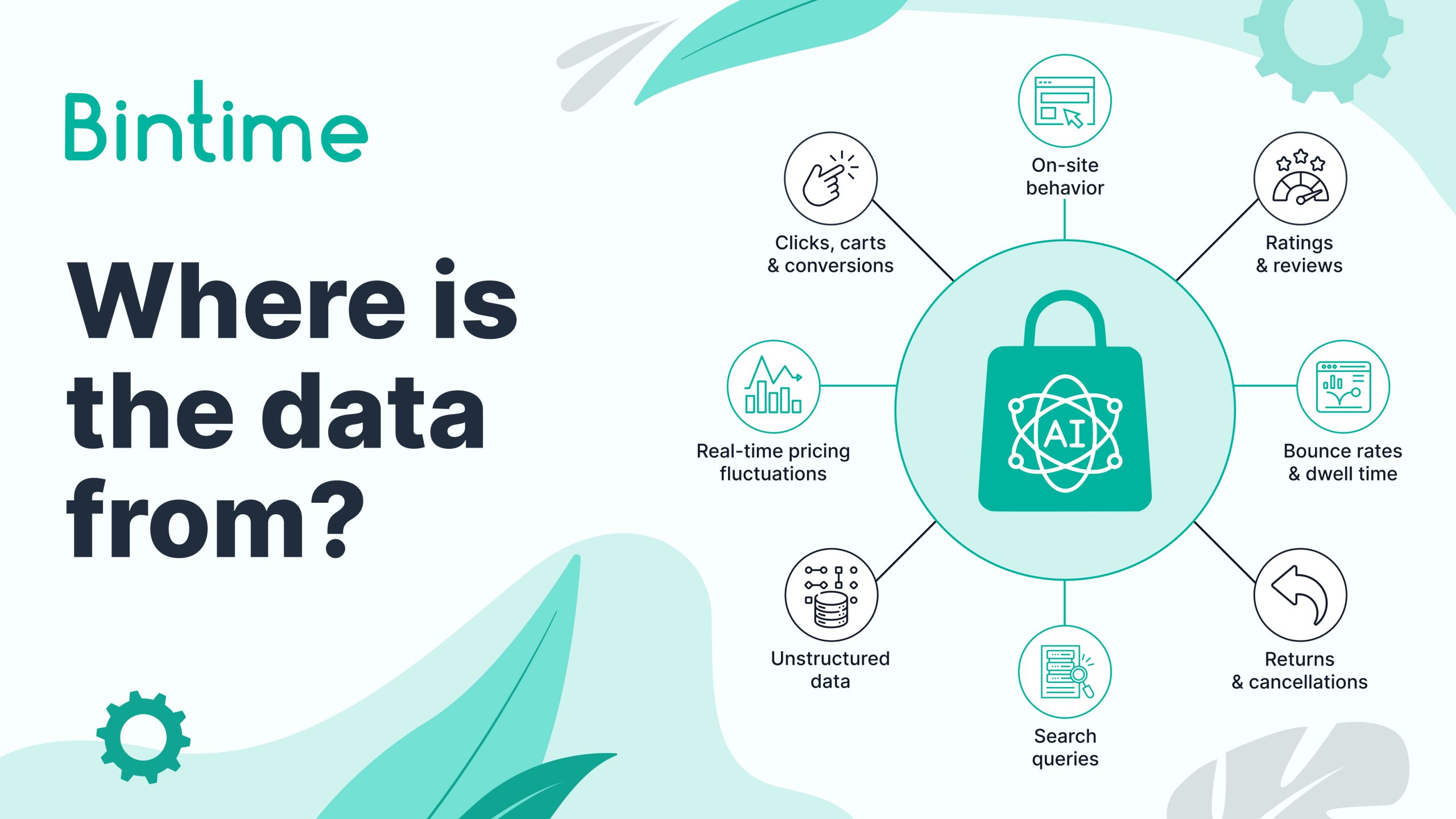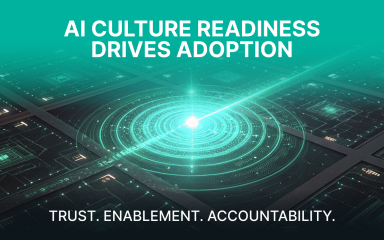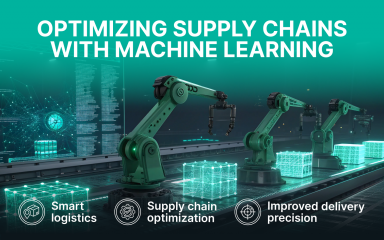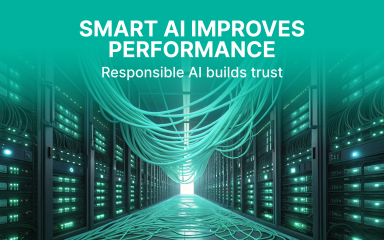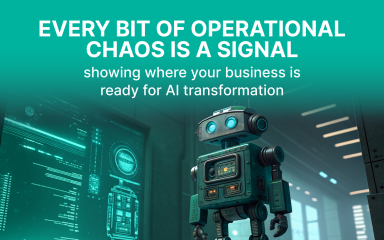AI for eCommerce analytics is no longer optional; it’s a must.
Let’s be real: eCommerce doesn’t need more dashboards. It needs better answers.
That’s where AI-powered analytics in retail and predictive insights enters the picture, turning raw data into sharp, actionable insights, delivering AI-powered commerce solutions that tell you exactly what’s working, what’s not, and what’s about to happen next. From AI for dynamic pricing to AI for inventory management, AI-based retail optimization helps brands cut through noise and make smarter moves faster.
This article breaks down how AI eCommerce tools work, how AI tools for eCommerce boost sales, and why AI in eCommerce is a game-changer for the future of eCommerce.
What is AI for eCommerce Analytics, and Why Should You Care?
The AI analytics definition includes tools powered by machine learning for eCommerce that analyze large datasets, identify patterns, and generate recommendations automatically. It’s a core part of the data-driven retail analytics movement, shifting from historical reporting to future-focused strategy.
If traditional eCommerce analytics tells you what happened, AI eCommerce shows what’s happening now and what’s coming next.
Here’s how it plays out:
- Traditional: “Here’s what happened last quarter.”
- AI-powered: “Here’s what’s likely to happen next and what you should do about it.”
In short: it’s not just analytics. It’s retail data intelligence.
And it’s all powered by machine learning eCommerce platforms that ingest millions of data points across customer behavior, sales trends, channel performance, pricing shifts, and more.
This reflects a broader industry shift. As Shopify CEO Tobi Lütke noted in an internal 2025 memo:
“Using AI effectively is now a fundamental expectation of everyone…”
It’s a clear sign that AI is no longer optional—it’s embedded into daily operations at the highest levels of modern eCommerce companies.
Where does the data come from?
Every touchpoint becomes a breadcrumb. And AI in shopping follows them all.
We’re talking:
- Clicks, carts, and conversions
- Bounce rates and dwell time
- Search queries (typed and voice)
- Ratings and reviews (positive, negative, and everything in between)
- Returns, cancellations, and refund reasons
- Inventory levels, logistics data, and supplier delays
- Real-time pricing fluctuations, you and your competitors’
- On-site behavior across devices and channels
- Even unstructured inputs like product images, UGC, and chatbot for shopping transcripts
All of these sources contribute to big data, enabling AI to process large datasets essential for advanced analytics in eCommerce.
Pulled from your D2C site, eCommerce platforms, Google Shopping, marketplaces, mobile apps, CRMs, and CDPs – this data powers advanced retail analytics solutions.
And AI doesn’t just store this data. It understands it.
What does AI actually do with it?
This is where the value compounds. AI in retail business doesn’t just store data; it understands it.
It can:
- Detect anomalies in performance
- Flag weak content (bad images, incomplete specs)
- Track competitors’ price shifts and promos
- Forecast demand using predictive metrics
- Segment users by behavior or customer lifetime value
- Identify digital shelf gaps (visibility, stockouts, search ranking issues)
- Deliver personalized AI recommendations in real-time
All of this, without ten dashboards or messy pivot tables.
The result? Less “What happened?” and more “Here’s what’s next.”
Use cases span every part of your operation, from AI for customer insights and AI for sales forecasting to predictive analytics in eCommerce and real-time retail analytics for reacting instantly to stockouts, price wars, or sudden traffic spikes.
This includes:
- Personalization AI that serves up tailored product recommendations and experiences
- AI-driven personalization across email, site layout, promotions, and loyalty flows
- Automated customer service via chatbots and smart assistants that can handle inquiries 24/7
All of this is built on the foundation of customer behavior analytics and connected data systems. AI turns fragmented inputs into a clear, actionable narrative telling you what to do next, not just what already happened.
Digital Shelf Optimization: Why Visibility Isn’t Optional Anymore
Imagine your product sitting on a shelf… but no one can see it.
That’s exactly what happens when your listings are incomplete, your stock runs dry, or your content doesn’t meet the algorithmic criteria of search engines and marketplaces. In eCommerce, visibility isn’t a nice-to-have.
Welcome to the digital shelf, where every product is competing for space, attention, and clicks. eCommerce sites and eCommerce brands must optimize their digital shelf – often with the help of AI for digital shelf analytics – to stand out and capture customer interest.
So, what exactly is the digital shelf?
The digital shelf meaning refers to your product’s online storefront. It’s the collection of elements that shape how your product appears across:
- Online marketplaces (Amazon, Walmart, Target)
- eCommerce websites
- Your D2C site and mobile apps
- Google Shopping and paid search
- Retailer partner sites
- Social commerce platforms (Instagram Shop, TikTok Shop)
- Voice search and virtual assistants
But unlike physical shelves, which might change once a week at most, the digital shelf is fluid. It’s governed by algorithms that constantly reshuffle listings based on price changes, keyword relevance, image quality, availability, engagement, and performance.
If you’re not actively managing your digital shelf with tools like AI for digital shelf analytics, your competitors probably are. And they’re winning product visibility online, shelf space, and customer mindshare in real time.
As highlighted in Google Cloud’s 2025 AI in Retail report:
“Generative AI has already had a significant impact on the retail industry by enabling businesses to run more personalized marketing campaigns, increase sales via improved search capabilities, and enhance customer service experiences through more accurate and tailored resolutions.”
How AI Improves Product Visibility and Shelf Performance
What makes up the digital shelf?

At a glance, it’s the full experience of discovering and evaluating your product online. Specifically:
- Product titles and descriptions: Keyword-optimized, skimmable, and structured
- Images and videos: High resolution, mobile-friendly, and conversion-tested
- Pricing and promotions: Competitive, timely, and synced across channels
- Stock availability: Real-time and accurate (nothing kills conversion like “out of stock”). This aligns with insights from Deloitte’s 2025 Retail Holiday Buyer Survey, which found that 44% of retail buyers prioritize AI-driven product assortment optimization – aiming to streamline inventory and ensure the right products are available at the right time.
- Ratings and reviews: Volume, recency, and sentiment all matter
- Search rankings: Are you ranking for relevant keywords, or buried on page 4?
These elements are evaluated by algorithms and customers. If they’re outdated, inconsistent, or incomplete, both will skip over you without hesitation.
And remember: it’s not about showing up, it’s about showing up right.
Why visibility and content matter more than ever
Shoppers rarely dig deep. Most won’t scroll past the top 10 results, let alone pages of listings. If your product isn’t visible on the first page or isn’t compelling when it’s seen, you’ve already lost the sale.
But product visibility online does more than drive clicks. It drives trust.
Customers assume that top results are more credible, better reviewed, or endorsed by the platform. If your product keeps showing up in relevant searches, you build familiarity. And familiarity builds purchase intent. Leveraging personalized shopping experiences: using AI-powered customer engagement and content strategy for eCommerce can further enhance engagement and boost conversion rates.
On the flip side, if your listings vary across channels or key details like pricing or descriptions are mismatched, this can cause confusion. That kills confidence. Fast.
Even worse? Many platforms now penalize inconsistent or non-compliant listings. Think: suppressed visibility, rejected ads, or even removal from search entirely.
So yes, content isn’t just for SEO. It’s the new packaging. And you better believe it’s being judged.
Key digital shelf metrics to monitor
If you’re serious about owning your category, these are the digital shelf KPIs you can’t afford to ignore:
| Metric | Why It Matters |
| Share of Search | Reflects how often your products appear for target keywords: your shelf visibility optimization |
| Product Content Score | Measures how complete, accurate, and optimized your listings are (and whether they meet platform standards) |
| Stock Availability | Low or inconsistent inventory signals unreliability to both platforms and customers. Leveraging real-time data is essential for accurate inventory management and ensuring products are always available. Inconsistent inventory hurts reliability. Use AI for shelf monitoring to prevent lost sales. |
| Rating Distribution | A strong average (4–5 stars) with recent reviews builds trust and improves ranking |
| Page Speed & Mobile Compatibility | Especially critical on D2C sites: impacts bounce rates and organic rankings |
| Product Listing Error Rate | Errors like broken images, missing specs, or duplicate titles directly hurt your discoverability |
These aren’t vanity stats. They’re levers. When you manage them consistently using shelf performance analytics and competitive pricing intelligence, you don’t just get more traffic; you convert more of it.
Without AI-powered pricing strategies, your pricing might look outdated. Without competitor analysis tools, your positioning might miss the mark.
And if they do find your product, but your content is weak or your inventory is spotty, they’ll just buy from someone else who got it right.
Winning the digital shelf isn’t just about gut feeling; it’s about data-driven retail analytics powered by AI for digital shelf analytics, giving brands real-time retail analytics visibility into what’s working and what’s missing.
Predictive Analytics in eCommerce: Forecasting the Future
You wouldn’t drive a car while only staring in the rearview mirror. So why run your business that way?
AI-powered predictive analytics in eCommerce flips the script on reactive decision-making. Instead of analyzing what already happened, it helps you look ahead – forecasting what’s likely to happen next and what to do about it now. By leveraging predictive analytics for eCommerce, businesses can anticipate shifts, optimize the customer journey, and make smarter moves with AI for marketing optimization, AI for inventory planning, and personalized marketing AI. Ecommerce businesses leverage AI to optimize business processes, streamline operations, and gain a competitive advantage in the market.
Whether it’s next week’s best-seller or a cohort of VIP customers on the brink of churn, AI-driven demand forecasting gives eCommerce leaders a crucial edge in planning, personalization, and performance.
How Does Predictive Analytics Work in Retail?
At its core, predictive analytics is about turning data into foresight. It uses machine learning for predictive analytics to detect patterns across massive datasets: purchases, pageviews, returns, reviews, even weather, and builds models to forecast outcomes. AI-powered predictive analytics in eCommerce relies on both current and historical data, including past purchases, to make accurate forecasts and drive actionable insights for sales, retention, and inventory.
A 2024 study by McKinsey reinforces this potential, showing that
“AI-driven demand forecasting can reduce supply chain errors by 20–50%, which in turn translates to a ~65% boost in operational efficiency by avoiding lost sales and out-of-stock scenarios.”
Predictive modeling in eCommerce relies on both current and historical data, including past purchases, to make accurate forecasts and drive actionable insights for sales forecasting with AI, customer retention analytics, and inventory optimization.
It’s not magic. But it feels like it when done right.
Key use cases in eCommerce:
- Sales forecasting
Predict demand for individual SKUs across time, region, and platform so you don’t overstock or underdeliver.
- Churn prediction
Spot high-risk customers based on engagement dips, negative sentiment, or delayed reorders, and trigger win-back campaigns using predictive analytics for customer behavior.
- Personalized marketing
Predict what each user is likely to click, buy, or ignore and serve content accordingly (from homepage banners to email flows).
- Inventory optimization
Balance stock across warehouses, channels, and fulfillment partners using demand forecasting AI and real-time signals.
- Campaign performance modeling
Simulate how a promotion or product drop might perform before you launch it: based on similar past initiatives, seasonality, and demand signals.
Why it matters:
- No more guessing how much to order
- No more scrambling during peak season
- No more wasted spend on the wrong audience
- No more blanket discounts when a precise nudge would’ve worked
And thanks to AI-powered predictive analytics in eCommerce, you can detect these patterns early, turning data into competitive strategy, not just hindsight.
AI Models Used in Predictive Analytics
You don’t need to be a data scientist to benefit from predictive models for retail, but it helps to know what’s happening under the hood. Think of these as the engine types powering your AI stack. Advanced algorithms drive these predictive models, enabling them to analyze complex data, enhance decision-making, and uncover valuable insights.
Time-Series Forecasting Models
These are used to forecast variables that evolve over time, like sales volume, traffic, or inventory levels, by analyzing retail time series and historical data.
- ARIMA (AutoRegressive Integrated Moving Average)
Great for short-term, stable datasets. Often used for weekly sales projections based on historical sales trends.
- Prophet (by Meta)
Handles holidays, trend shifts, and seasonality well. Easy to deploy and tune. A go-to for eCommerce season planning, especially when leveraging historical sales data for more accurate forecasts.
- LSTM (Long Short-Term Memory)
A type of neural network designed to capture long-term dependencies and irregular spikes. Think: COVID-like anomalies, viral trends, or sudden demand shifts.
Use cases:
→ Forecasting order volume
→ Anticipating returns
→ Estimating shipping load
Recommendation Engines
Used for real-time personalization and discovery. Recommendation engines analyze user intent to deliver relevant product suggestions, ensuring customers see items that match their current interests and needs. These improve both CX and AOV by surfacing the right product at the right time.
- Collaborative Filtering
Recommends based on user behavior (“Customers who bought this also bought…”). Works best with lots of interaction data.
- Content-Based Filtering
Suggests similar products based on attributes like brand, color, category, or price. Ideal for new product launches or niche catalogs.
Together, they can dynamically adjust:
- Product carousels
- Email recommendations
- Checkout upsells
- “You may also like” modules
Customer Lifetime Value (CLV) Models
Every customer isn’t created equal. That’s why you need lifetime value prediction tools to treat them accordingly.
What they do:
- Predict how much a customer is likely to spend over their lifetime
- Enable customer segmentation by grouping users based on projected value, behavior, and preferences
- Segment users based on projected value (high, medium, low)
- Inform loyalty programs, reactivation flows, and ad retargeting budget
For example:
→ Don’t offer a 20% discount to someone who was going to buy anyway.
→ Do offer a premium bundle or concierge-level service to a high-value shopper showing signs of churn.
By focusing on predicted value, not just past behavior, you move from reactive to profitable prioritization.
Predictive analytics doesn’t just help you anticipate the future – it helps you shape it. It’s how smart retailers:
- Avoid overstock
- Fix problems before they hurt revenue
- Create personalization that actually converts
- Build stronger margins without playing guessing games
If you’re serious about future-proofing your eCommerce business, predictive analytics isn’t a bonus; it’s a basic.
Implementing AI in Your eCommerce Strategy
Okay, so AI sounds powerful. But how do you actually make it part of your daily operations without drowning in jargon, ballooning costs, or endless stakeholder back-and-forth?
Here’s the good news: you don’t need to go full sci-fi on day one. You don’t even need to build your own model from scratch. Implementing AI in eCommerce is more like assembling IKEA furniture: start with the basics, follow clear steps, and keep your screws (data) organized. Choosing the right AI technology is crucial, as it ensures your business leverages the most effective tools and platforms for your specific needs.
According to Adobe’s 2025 Digital Trends Report, 65% of senior executives identify leveraging AI and predictive analytics as primary contributors to growth in 2025.
These stats underscore why choosing and implementing the right AI tools isn’t just a tech decision – it’s a growth strategy.
AI can also optimize your supply chain by improving logistics, demand forecasting, and overall operational efficiency through data-driven insights.
This AI implementation process helps avoid costly errors and ensures your tools align with business priorities from day one. Selecting AI vendors carefully, building a strong data pipeline for AI, and understanding the full AI deployment steps gives you the clarity you need.
Step-by-Step Guide to Deploy AI
Let’s break it into four phases that most teams can follow regardless of size or tech maturity. This framework supports data-driven decision-making in eCommerce by leveraging AI insights, historical data, and machine learning model deployment effectively.

1. Clean and prep your data
Garbage in = garbage insights.
Data preparation for AI starts with product content, inventory info, and customer behavior tracking. That means:
- Audit your product catalog: titles, descriptions, images, tags, availability
- Standardize naming conventions, specs, and categories across platforms
- Eliminate duplicates and outdated SKUs
- Use a Product Information Management (PIM) system if you’re managing hundreds or thousands of products
A well-structured data pipeline for AI ensures your insights are accurate, your predictions are reliable, and your dashboards don’t get bogged down in noise. Applying computer science principles, such as algorithms and data structures, is essential for maintaining data quality and consistency throughout this process. It ensures reliable outcomes, accurate predictions, and smooth AI model training.
As Microsoft CEO Satya Nadella put it,
“Every AI application requires a database, a Kubernetes cluster, and a model on an AI accelerator.”
Underscores a critical reality: the success of Agentic AI hinges not only on the model and the intelligence of the agents but also on the robustness of the systems and infrastructure that power them.
Think of it as brushing your teeth before putting on lipstick. You can skip it, but… should you?
2. Choose the right solution
This is where people get overwhelmed. Don’t. You have two options:
- Option 1: Off-the-shelf AI platforms
These come with built-in models for forecasting, shelf analytics, product scoring, personalization, and content creation. Great for fast setup and predictable ROI.
→ Examples: Gepard, Salsify, Triple Whale, Blue Yonder, Peak.ai, AI writing assistant (for generating product descriptions and marketing copy)
- Option 2: Custom-built models
If you’ve got a data science team and niche use cases, build your own with Python, BigQuery, or Spark.
→ This gives full control and flexibility but comes with higher costs and longer ramp-up.
Not sure where to start?
Pilot with an off-the-shelf tool. If it works and your needs grow, you can always move to a custom build or hybrid model later.
3. Integrate with your existing stack
AI isn’t helpful if it’s siloed.
To generate insights that are actually actionable, your AI needs access to:
- eCommerce platforms (Shopify, Magento, BigCommerce)
- ERP systems (for stock, suppliers, fulfillment)
- CRM/CDP platforms (for customer behavior and segmentation)
- Marketing tools (email automation, ad campaigns, personalization engines)
- Analytics dashboards (Looker, Power BI, or even Google Data Studio)
Seamless integration with these marketing tools is essential for improving marketing efficiency, as it enables data-driven strategies and better utilization of marketing resources. AI integration with eCommerce platforms and tools like ERP, CRM, and analytics dashboards is crucial. If your AI lacks access to inventory, pricing, or customer behavior, it can’t deliver actionable results.
Look for platforms that support eCommerce system integration and allow real-time data syncs. Think integrating AI with ERP/CRM, marketing platforms, and personalization engines.
4. Test, iterate, scale
Treat every project as a sprint. Test, evaluate, and optimize. This is the essence of AI testing and optimization.
Here’s a sample rollout timeline:
| Phase | What to Do |
| Week 1–4 | Pilot on one product category or channel (e.g., Amazon listings only) |
| Week 5–8 | Monitor KPIs: did shelf performance or forecast accuracy improve? |
| Week 9–12 | Refine settings, retrain models, or expand to a second use case |
| Month 4+ | Roll out to additional categories, channels, or geo-markets |
Keep your scope tight early on. AI success comes from continuous iteration, not perfection.
Common Challenges (and How to Handle Them Without Losing Your Mind)
Most AI implementation challenges stem from people and process, not the tech itself.
When implementing AI solutions, especially in areas like fraud detection, it’s crucial to ensure the system can accurately distinguish between fraudulent and legitimate customers to protect genuine buyers and maintain a positive user experience.
Here’s what usually trips teams up and how to fix it.
Poor data quality
Still the #1 reason AI projects stall or underperform.
Fix: Prioritize a cross-functional data cleanup sprint. Assign clear data ownership. Don’t let 12 different versions of “navy blue” clog your system.
Internal resistance
Some staff fear automation will replace their jobs. Others are skeptical of AI “black boxes” telling them how to do theirs.
Fix: Involve team leads early. Show how AI enhances, not replaces, decision-making. And share wins often: “AI spotted a pricing issue that saved us $8K last month” > any slide deck.
Compliance confusion
GDPR, CCPA, and platform-specific rules mean you can’t just plug in data and let it fly.
Fix: work with legal on GDPR compliance in AI and ensure data privacy in AI via trusted vendors
Lack of in-house expertise
Even with good tools, someone needs to understand the output and connect it to business goals.
Fix: Assign a hybrid role: someone who can speak both “AI” and “eCommerce.” Could be an analyst, a tech-savvy category manager, or your most curious merchandiser.
Pro tip: Look for platforms with strong UX and human-readable dashboards. If your team needs to decode JSON just to optimize a product listing, it’s not going to scale.
Final Word on Implementation
You don’t need to be perfect; you just need to be moving.
Start with one problem that AI can clearly solve: out-of-stock alerts, inconsistent listings, margin forecasting, churn detection, whatever hurts most. Solve that. Show the results. Then go deeper.
AI isn’t a silver bullet. But it is a repeatable engine for insight, automation, and smarter decisions: if you build it on clean data, clear priorities, and consistent iteration.
Measuring the Business Impact of AI in eCommerce
Implementing AI without tracking its business impact is like hiring a genius consultant and never reading their report.
The good news? AI analytics for business outcomes is highly measurable. Whether it’s product visibility, conversion rate improvement, or customer lifetime value enhancement, nearly every metric can be tied directly to AI-driven performance metrics and actual revenue.
And that’s exactly what stakeholders want: not a buzzword, but a business case rooted in AI ROI metrics.
What ROI Can You Expect from AI?
While ROI will vary based on data maturity, tech stack, and use case, most retailers see measurable gains within 6–12 months. Sometimes sooner, especially when applying AI for AOV optimization, personalized experiences, or dynamic pricing strategies.
Typical performance improvements with AI:
- 5–15% boost in conversion rate via smarter targeting and AI for conversion optimization
- 10–25% lift in average order value (AOV) through bundling, upsells, and AI-based marketing strategies
- 20–30% higher demand forecasting accuracy for leaner inventory
- Up to 40% drop in out-of-stocks through AI-driven sales growth and replenishment alerts
- Lower returns from improved product alignment
- Higher retention through AI-powered customer segmentation and predictive engagement
According to AI for Customer Retention research,
“Companies using AI-based churn prediction see a 20–30% improvement in retention rates.”
And here’s the kicker: these gains stack. Each improved touchpoint multiplies the value of the next, resulting in sustained, AI-driven performance improvements over time.
KPIs to Track AI’s Impact
To go from “AI sounds cool” to “AI is profitable,” you need to measure the right key eCommerce KPIs tied to business outcomes.
| KPI | Why It Matters |
| Conversion Rate | Tracks sales uplift and content performance through AI performance tracking |
| Average Order Value (AOV) | Reflects AI for AOV optimization and cross-sell success |
| Customer Lifetime Value (CLV) | Demonstrates customer lifetime value improvement through retention strategies |
| Churn Rate | Reveals how well AI is preventing customer drop-off with predictive signals |
| Return Rate | Reflects the accuracy of product discovery and alignment with shopper intent |
| Share of Search | Indicates how often your products show up for key queries – a visibility benchmark |
| Time on Site | Suggests deeper engagement through smarter content, layout, and recommendations |
| Operational Efficiency | Reveals measuring AI success in eCommerce via automation time savings |
If you’re not seeing impact across at least three of these areas, your AI might be underutilized, or your data may still need cleanup.
Before/After Snapshot (Actual Examples)
| Metric | Before AI | After AI |
| Conversion Rate | 2.3% | 2.9–3.4% |
| AOV | $45 | $50–$54 |
| Out-of-Stock Rate | 12% | 6–7% |
| CLV | $180 | $220–$260 |
| Forecast Accuracy | ~70% | ~90% |
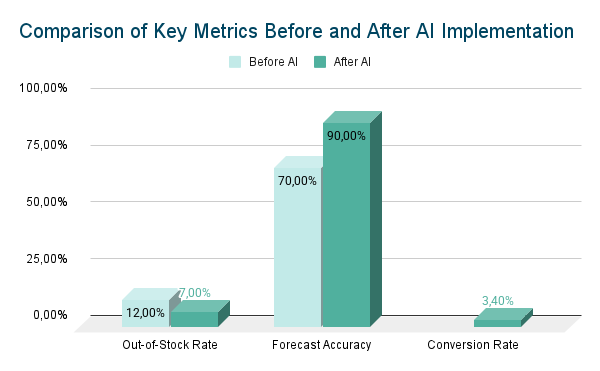
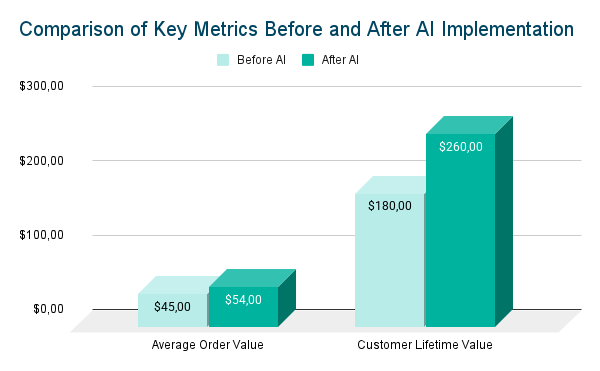
These before and after AI results aren’t just vanity metrics: they’re measurable proof of how AI for decision-making drives smarter, faster growth.
Also worth noting: the longer AI runs, the smarter it gets. With more data, your models become more accurate and more profitable.
Competitive Advantage Through AI
Let’s be blunt: most retailers today have similar tools. A solid platform. A data dashboard. Maybe a loyalty program or two.
So what creates real eCommerce differentiation?
IBM’s 2025 retail study confirms this shift: 81% of surveyed executives say they’re actively using AI today – not as an experiment, but as a core capability.
“AI is no longer just a tool; it’s a strategic imperative,” says Dee Waddell, IBM Global Consumer Industry Leader.
Real-time AI insights. AI-powered customer engagement. And AI for competitive edge.
What AI-powered retailers can do that others can’t:
- Make AI-driven decision-making in real time (e.g., detect stockouts before they hurt)
- Deliver personalized shopping experiences at scale
- Target customers precisely using AI-powered customer segmentation
- Continuously optimize listings with AI content audit tools
- Forecast revenue with AI analytics for business outcomes and act faster than the competition
Real-world example paths:
- A shopper lingers on a product page but doesn’t convert?
→ AI triggers a personalized offer in the next email.
- A segment of high-CLV customers starts showing signs of disengagement?
→ AI launches a loyalty reactivation sequence with exclusive perks.
- A new product launches next week?
→ AI identifies your “likely buyer” segment and recommends optimal placement and promo channels.
These moves used to take weeks of analysis. Now they happen in near-real-time – and without constant human intervention.
In 2025 and beyond, the edge won’t come from who has the most data. It’ll come from who acts on it the fastest.
That’s the core of competitive advantage through AI: amplifying human decisions with scalable personalization with AI, speed, and clarity.
Future Trends in AI for eCommerce
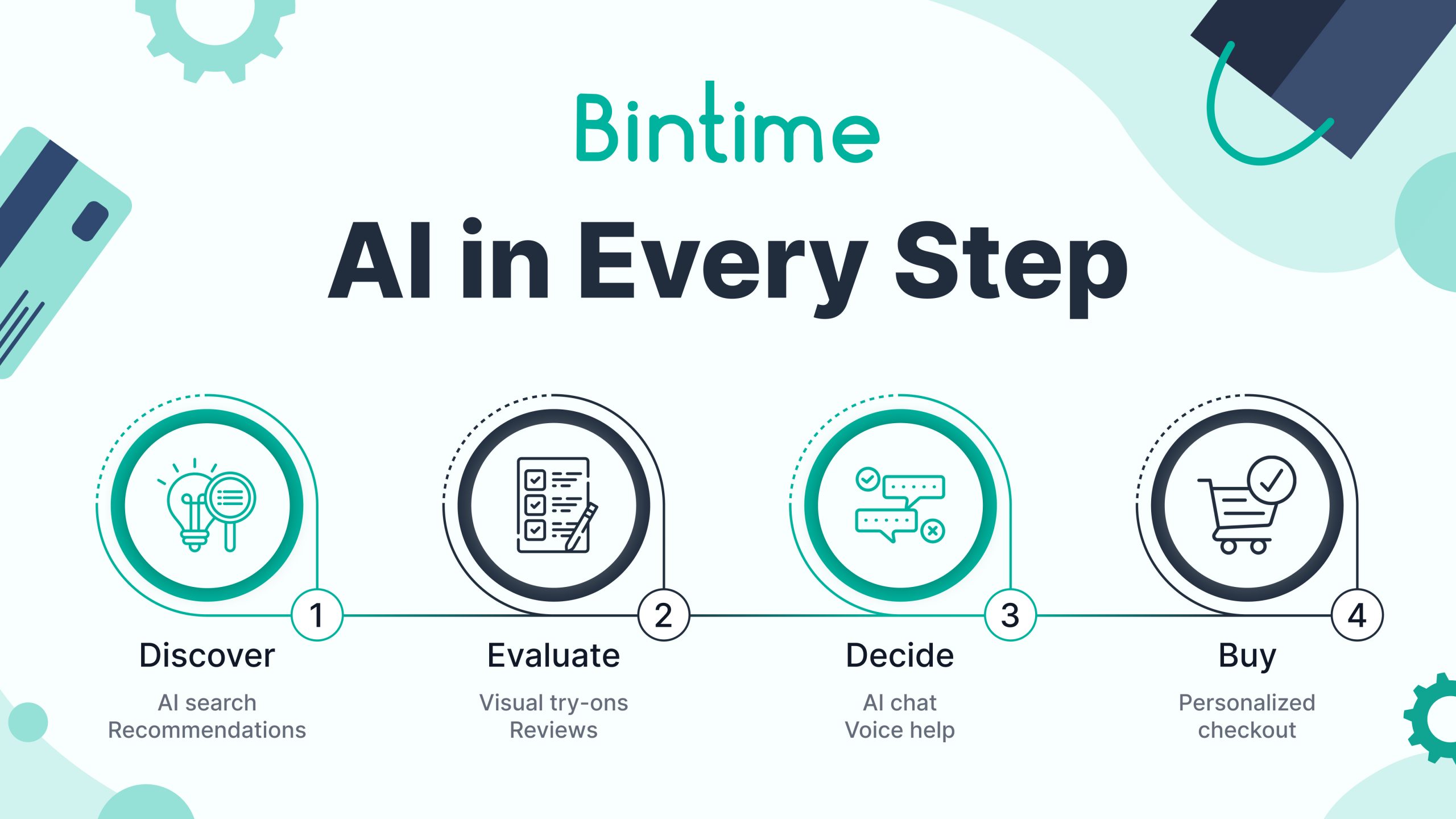
If today’s AI helps you play catch-up, tomorrow’s AI will help you lead.
We’re entering an era where AI isn’t just assisting your team; it’s reshaping how customers discover, evaluate, and buy. The next wave of tools is creative, immersive, context-aware, and optimized for voice commerce and automated content creation. And it’s already gaining traction with early adopters.
Future AI will increasingly process unstructured data, enabling deeper insights and more accurate predictions than ever before. These aren’t distant futures. They’re unfolding now, and brands that start experimenting today with AI-driven content strategy or AI-powered visual search will be better positioned to dominate tomorrow.
As Amazon CEO Andy Jassy noted in a 2025 internal letter:
“Today, in virtually every corner of the company, we’re using Generative AI to make customers’ lives better and easier. Technologies like Generative AI are rare; they come about once-in-a-lifetime, and completely change what’s possible for customers and businesses…”
Here are three transformational trends worth embedding into your long-term roadmap.
How Generative AI Is Transforming Content Creation
Generative AI for eCommerce is more than just a productivity tool. It’s your content studio, SEO strategist, and testing engine: on-demand, always learning.
What’s happening now:
- AI-generated product descriptions
Tools like ChatGPT, Jasper, and Copy.ai can create thousands of unique, high-converting product blurbs in minutes. They pull from structured data, like SKU specs, categories, reviews, and turn it into human-friendly copy.
- SEO automation with AI
Advanced AI SEO content tools scan your catalog and create optimized titles, tags, and meta descriptions. They even benchmark GPT product content against competitors.
- Dynamic marketing content
AI now creates and tests personalized ad copy, subject lines, and landing pages at scale, making AI for content marketing automation a reality.
Why it matters:
- Shortens time to market for new SKUs
- Supports localization without bloating your creative team
- Enables real-time campaign iteration based on performance data
- Democratizes good content, even for smaller teams
Early adopters like Nestlé, Levi’s, and Sephora are already localizing generative product content across languages and categories with 10x speed. And many D2C brands are now using AI to manage seasonal campaigns, SEO hubs, and user-generated review summaries.
Generative AI doesn’t just create faster. It creates smarter, especially when fed with real performance data.
Visual AI and AR in Shopping
In a world where 75% of shoppers say visuals impact their buying decisions, visual AI tools are becoming just as important as copy.
Innovations gaining traction:
- Virtual try-on tools
Popular in beauty and eyewear (Sephora, Warby Parker), now used for apparel, decor, and more. These tools enable AI in virtual try-ons, offering a virtual shopping experience from any smartphone.
- Smart image generation
Tools like Claid and Vue.ai now offer AI-driven visual recognition, automatically generating 3D mockups, background swaps, and lighting edits.
- AI-powered visual search
Snap a pic of an item and instantly find it (or similar) in your catalog. This augmented reality shopping feature is particularly powerful in mobile-first markets.
- AR-based shopping experiences
IKEA, Amazon, and Wayfair are already integrating interactive shopping with AR, allowing shoppers to place products in real-life settings via phone camera.
Why it matters:
- Lowers return rates by setting better expectations
- Increases conversion by building confidence pre-purchase
- Makes product discovery frictionless
- Enhances accessibility for mobile-first and younger users
- Supports AR for retail and AI-enhanced UX
Enhancing shopping experience with AR isn’t just “cool”; it’s commercial.
Conversational AI and Voice Commerce
As screens get smaller and attention spans shorter, customers are moving from clicking to talking, and AI is listening. Natural language processing (NLP) enables these conversational AI experiences by allowing systems to understand and generate human language, making interactions more intuitive and engaging.
What’s trending now:
- AI-powered chatbots and virtual assistants
Today’s shopping assistant AI tools (e.g., Zendesk AI, Intercom Fin) handle upsells, FAQs, recommendations – even jokes – with contextual memory and human-like tone.
- Voice commerce through Alexa, Siri, and Google Assistant
Shoppers are already using voice-activated shopping to reorder staples or browse options hands-free. Expect a surge in Google voice commerce and Alexa voice shopping as usage grows.
- Shopping assistants that know you
Think AI that remembers your dietary restrictions, sizing preferences, or last-minute gifting habits and guides you through the purchase journey. It’s like having a personal stylist, but algorithmic.
- Conversational search optimization
With more users asking “What’s the best waterproof hiking boot under $100?”, content needs to be optimized for voice search for retail and natural-language indexing.
Why it matters:
- Enables hands-free shopping across smart devices
- Deepens emotional connection through AI-powered customer service
- Supports smart shopping assistants for accessibility
- Drives sales during “micro-moments” of casual browsing
In the same way email revolutionized customer service, voice and chat are rewriting the script for product discovery and decision-making.
Where It’s Headed Next
Here’s what’s coming down the pipe, and why you should care:
- AI-powered design assistants for real-time site personalization
- Predictive UX flows that reshape based on user behavior, not static funnels
- Multimodal AI, blending voice, visuals, and text in a single shopping interaction
- Synthetic influencers and AI-generated product demos on TikTok and Instagram
- Emotion-aware AI that reads facial expressions or sentiment in messages to shape responses (yes, it’s already in beta)
Final Word on the Future
AI is no longer about dashboards and data science. It’s about experience.
The next generation of AI-powered commerce will reinvent how people shop. And brands that lean into this future from voice commerce trends to automated content creation, will win not just transactions, but loyalty.
So start experimenting.
The future of eCommerce won’t wait.
FAQ:
What’s the difference between traditional analytics and AI analytics in eCommerce?
Traditional analytics shows you what happened in the past like sales numbers, bounce rates, campaign performance.
AI goes further: it identifies patterns, learns from real-time behavior, and predicts future outcomes like demand spikes, churn risk, or conversion likelihood. It’s forward-looking, not just reflective.
How can AI help improve customer retention?
AI detects early warning signs – like reduced session length, cart abandonment, or lapsed orders – and responds with actions that drive customer engagement, such as:
- Personalized win-back emails
- Dynamic discount offers
- Product recommendations based on previous behavior
This increases the odds of saving a customer before they churn.
What tools do I need to get started with AI in eCommerce?
Here’s the basic tech stack:
| Category | Examples/Notes |
| Data Platform | BigQuery, Snowflake, AWS Redshift |
| AI/ML Engine | Vertex AI, Azure ML, OpenAI, GPT APIs |
| eCommerce Stack | Shopify, Magento, BigCommerce |
| CRM/CDP | HubSpot, Klaviyo, Salesforce, Segment |
| PIM/CMS | Gepard, Salsify, Contentful |
| BI Tools | Looker, Power BI, Tableau |
Start small with tools that integrate directly with your eCommerce stack. Many platforms already include embedded AI features.
How do I calculate ROI from AI projects?
Track performance across three categories:
- Revenue Lift – Conversion rate, AOV, and CLV before vs. after AI
- Efficiency Gains – Time saved in tasks like pricing updates or shelf audits
- Error Reduction – Fewer stockouts, better forecasting, improved targeting
Then use this formula:
ROI % = (Gain – Cost) / Cost × 100
Tip: ROI tends to grow over time as models learn and improve.
What are the biggest blockers to AI adoption in eCommerce?
Most challenges fall into these categories:
| Barrier | Description |
| Dirty/fragmented data | Inconsistent fields, duplicates, and missing specs reduce AI accuracy |
| Upfront cost concerns | Lack of clarity on timelines and payback periods |
| Team resistance | Fears of job loss or unfamiliarity with AI tools |
| Compliance complexity | Especially in GDPR, CCPA, or sensitive customer data situations |
| Lack of in-house expertise | No clear owner or AI translator between teams |
Solution: start with one focused use case and assign clear owners to manage both tech and outcomes.
Do I need a data science team to use AI tools effectively?
Not necessarily.
Many AI tools today are:
- No-code/low-code (drag-and-drop dashboards, pre-trained models)
- Designed for marketing, merchandising, or ops teams
- Pre-integrated with common platforms like Shopify or Salesforce
However, for deeper customization or proprietary model development, having access to a data analyst or ML engineer makes a big difference.
Final Thought
You don’t have to overhaul your entire business to benefit from AI.
You don’t need a team of data scientists or a six-figure budget. What you do need is clarity: a specific problem worth solving, and the willingness to start with what’s already within reach.
Whether it’s optimizing your digital shelf, forecasting demand with more accuracy, or finally fixing that churn problem: AI is most powerful when it’s practical. Start where the friction is. Start where you’re bleeding time, money, or momentum.
Because here’s the thing: AI isn’t a silver bullet. It’s a series of small, smart upgrades that compound over time. The more you feed it, the sharper it gets. The more you apply it, the more your team learns how to think in probabilities, not just performance reports.
Don’t wait for a “perfect” AI rollout. Start with a useful one.
The brands winning in 2025? They’re not waiting for AI to mature. They’re building muscle with the tools available now and improving with every click, query, and customer interaction.
They’re not just using AI to optimize margins.
They’re using it to outpace competitors, delight customers, and make better decisions faster.
And you can, too.
Start small. Move fast. Stay curious.
Your future customers are already there. Make sure your business is ready for them.
